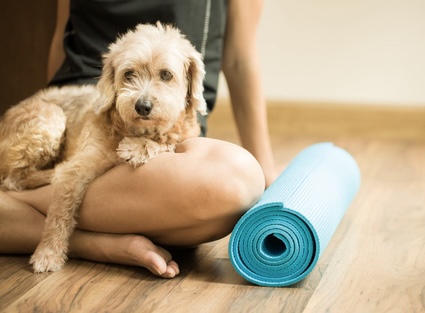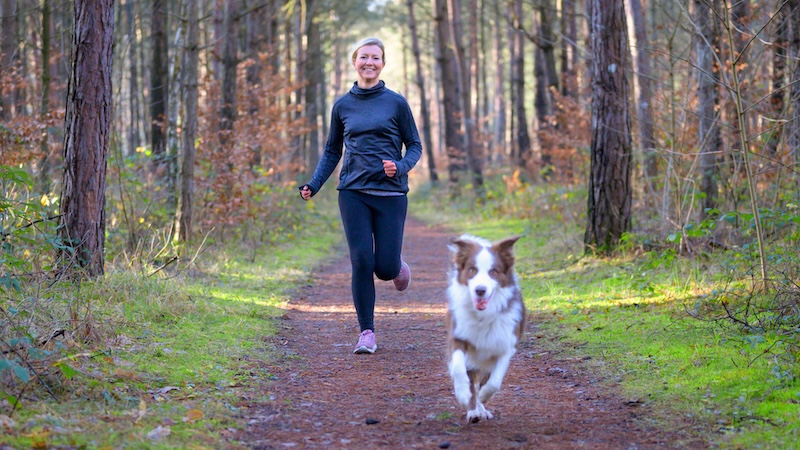If you’d like to exercise and still spend time with your dog, these health-promoting, pet-friendly fitness trends may be for you.
As we age, staying active becomes less about performance and more about connection – to our bodies or perhaps our environments. And for many older adults, maintaining health and mobility is easier and more rewarding when it includes a special canine companion.
Pet-friendly fitness is a growing accessible wellness trend today, even among active seniors. Whether you’re taking your dog for a walk, trying a doga class (yoga with your dog), or enjoying a run together, these shared routines offer both physical and emotional benefits for both human and animal.
The health benefits of exercising with your dog
The intuitive companionship between people and dogs underscores a key truth: dogs aren’t just workout partners. They can be conscious companions with a sensitivity that goes beyond typical trainer-client dynamics, and that awareness matters. The research backs it up the benefits of having a pet. In fact, pet ownership among older adults has been linked with higher levels of physical activity and slower decline in mobility. In an Oxford Academic study of men and women age 50 to 100, those who owned pets experienced a slower decline in physical function than those without pets. Another Newswise study found that seniors who engaged in walking with their dogs reported more frequent exercise sessions, fewer doctor visits, and lower body mass index than non‑owners.
Increasingly, fitness professionals and wellness advocates are recognizing the value of incorporating dogs into exercise routines. Better yet, the health benefits of exercising with our pets aren’t just for us. PetDaily notes that such shared exercise sessions produce improved health and happiness for both owner and pet.
Top pet-friendly fitness trends
Yoga with your dog
 One popular pet-friendly activity is doga. While your dog won’t mimic your downward dog (or maybe it will!), the idea is to share space and presence during gentle stretches and breathing exercises. This trend is a bit more accessible than another popular one – goat yoga!
One popular pet-friendly activity is doga. While your dog won’t mimic your downward dog (or maybe it will!), the idea is to share space and presence during gentle stretches and breathing exercises. This trend is a bit more accessible than another popular one – goat yoga!
Many classes geared toward older adults offer chair-based poses, which are ideal for those with limited mobility. Your calm breathing may help relax your dog, and your furry friend’s quiet presence can help you stay grounded.
If no in-person classes are available in your area, online doga videos can be a great way to incorporate mindful movement sessions into your home routine.
Jog with your dog
For those looking for something more vigorous, running or jogging with your dog is a fantastic way to stay in shape. It’s become so common that some newer businesses, like Ruffwear, base their product lines entirely on dog exercise equipment. Other exercise-focused businesses, such as Noxgear, include nighttime illuminated products for pets like those for people.
If running and jogging aren’t for you, walking offers similar benefits.
Before beginning, here are a few guidelines for running safely with your dog:
- Training: Make sure your dog is leash-trained and responsive to basic commands.
- Equipment: Use a secure harness, collar, or leash that prevents sudden pulling.
- Weather: Avoid high heat or icy conditions. Bring hydration for both of you.
- Pacing: Let go of time goals – build in breaks sniffing, water, and potty stops. Staying connected and balanced is more important than the steps on a fitness tracker or minutes on a watch.
- Recovery: Give both yourself and your dog time to recover.
More options for exercising with your dog
Pet‑friendly fitness is not limited to yoga or running. Agility training – leading them through obstacles such as tunnels, weave poles, portable jumps – can be done as a fun backyard workout or at dedicated dog facilities. Hiking with your dog provides nature immersion, mental stimulation for your dog (new smells, new terrain), and physical challenge. Some fitness centers now are explicitly pet‑friendly or offer classes where dogs can join in, transforming exercise into a shared adventure. These broader trends reflect a growing understanding that fitness doesn’t have to be solitary or strictly human‑centric – it can be relational.
Trust their instincts for safety
Annie Tobey, Seniors Guide editor, knows firsthand that dogs often know best. Her high-energy Australian shepherd, Newt, helps her stay active, with plenty of walks and runs. They run together on neighborhood streets and wooded trails, forging not just a fitness routine, but a partnership.
“He’s very responsive to my voice and my movements, even when he wants to go one way and I want to go another,” she says. “If I slow or stumble, he looks back to make sure I’m okay.”
One recent experience in the Blue Ridge Mountains stands out. “He stopped and began attentively sniffing the air,” Tobey recalls. “Then he did a hard about-face and refused to go any farther. I tried to coax him forward, but he wouldn’t budge. I let him lead, and he took us straight back to the cabin.” Later, the camp host mentioned there had been bobcat sightings nearby, which may explain the herd of deer that had run past just moments before.
It’s a reminder that dogs aren’t just workout partners. They’re deeply aware companions that are sensitive to our wellbeing and attuned to the environment in ways we often aren’t. That kind of relationship makes exercise safer and more meaningful.
Find the right dog (or adjust with your current pet)
If you’re considering a dog specifically for exercise, the breed and temperament matter. High-energy breeds like border collies, Vizslas, German shorthaired pointers and Australian shepherds typically enjoy running. Working dogs value the “job” of exploring their environment. But age, health, and personality are just as important. If your dog is older or has joint issues, opt for gentler activities like walking or doga.
Above all, prioritize quality over quantity. A joyful 20-minute walk with your dog is better than forcing a long run you both dread.
If you’re ready to incorporate your dog into your fitness routine, schedule a check-up for both you and your dog. Begin with short walks two to three times a week, and slowly add other activities such as yoga sessions, short jogs, or nature walks. Track how you feel, not just how far you go.
As Annie Tobey’s story reminds us, trust and awareness go both ways: your dog trusts you to lead, and you trust your dog’s instincts to guide. That mutual care – rooted in movement, attention, and companionship – may be one of the most meaningful wellness tools we have.





